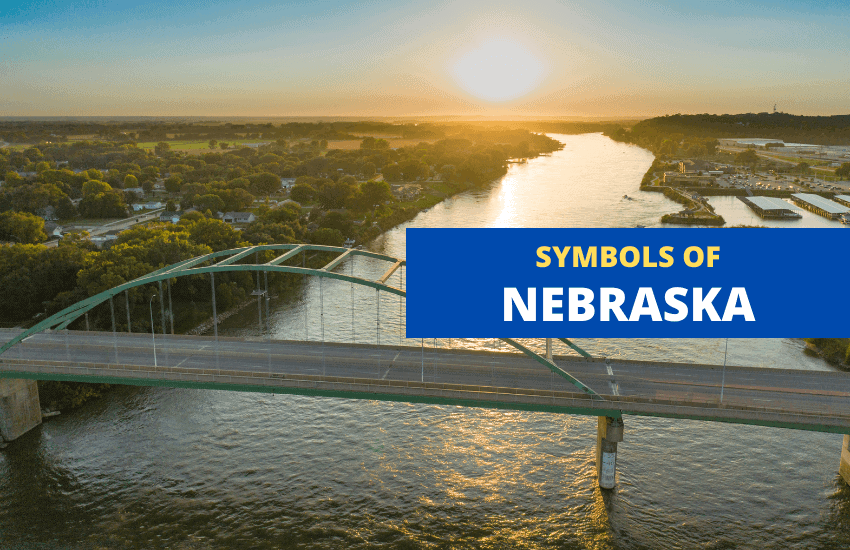
Table of Contents
Nebraska is one of the most beautiful U.S. states with more miles of river than any other. Home to Reuben Sandwich and the College World Series, the state is known for its beautiful natural wonders, delicious food and things to do, which is why millions of people visit the state every year.
Nebraska joined the Union as the 37th state in March 1867, two years after the American Civil War saw its end. Its capital city Lancaster was then renamed Lincoln after Abraham Lincoln the 16th president of the U.S.
Nebraska has a lengthy list of state symbols but in this article, we’ll be taking a look at just a few of the official and unofficial ones that are strongly associated with the state.
The Flag of Nebraska
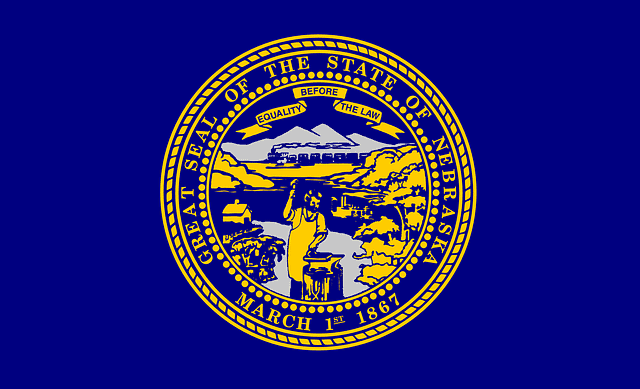
Nebraska, one of the last U.S. states to officially adopt a state flag finally designated the current flag design in 1924. It consists of the state seal in gold and silver, superimposed on a blue field.
The flag’s design has drawn some criticism for being unappealing. The design wasn’t changed until State Senator Burke Harr proposed to have it redesigned, saying that it had been flown upside down at the state capitol for 10 days without anybody noticing. The State Senate committee refused to take action.
The North American Vexillological Association conducted a survey of 72 United States and Canadian flags and the Nebraskan flag was voted the second worst, the first being the flag of Georgia.
State Seal of Nebraska
Nebraska’s state seal, used only by the Secretary of State on all official state documents, features many important state symbols.
Adopted in 1876, the seal features a steamboat on the Missouri River, some sheaves of wheat and a simple cabin, all of which represent the importance of agriculture and settlers. A blacksmith working with an anvil is in the foreground as a symbol of the mechanical arts.
The rocky mountains can be seen in the foreground and at the top is a banner with the state motto ‘Equality Before the Law’. Around the outer edge of the seal are the words ‘GREAT SEAL OF THE STATE OF NEBRASKA’ and the date Nebraska became a state: March 1st, 1867.
State Fish: Channel Catfish
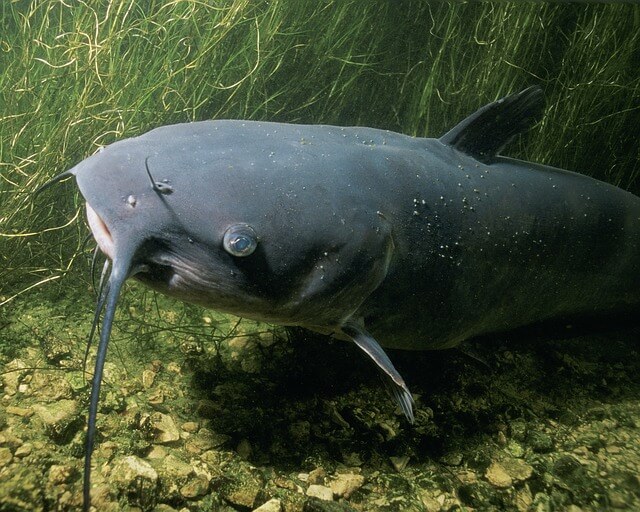
The channel catfish is the most numerous species of catfish found in North America. It’s the state fish of several U.S. states, including Nebraska and is commonly seen in reservoirs, rivers, ponds and natural lakes throughout the country. Channel catfish are omnivores that possess a very keen sense of taste and smell. In fact, they have taste buds all over the entire surface of the body, especially on the 4 pairs of whiskers around the mouth. Their extremely sharp senses allow them to find food easily in muddy or dark water. The channel catfish was designated the official state fish of Nebraska in 1997.
State Gemstone: Blue Chalcedony
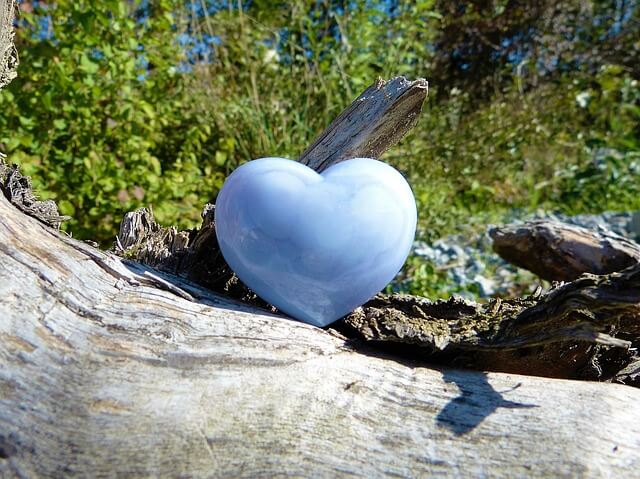
Blue Chalcedony (also known as blue agate) is a compact and microcrystalline form of quartz with a waxy to vitreous luster. It gets its color from traces of minerals like manganese, iron, titanium and copper. While it displays various shades of blue such as sky blue, robin’s egg blue or violet blue, there are also pale stones which have internal bands of white and blue, with a colorless streak.
Blue Chalcedony is found in abundance in northwestern Nebraska where it formed in claystone and wind-blown silt that was deposited in the Charon Formation during the Oligocene Age. It’s popularly used for making jewelry and in 1967 the state of Nebraska designated it as the official state gemstone.
Carhenge
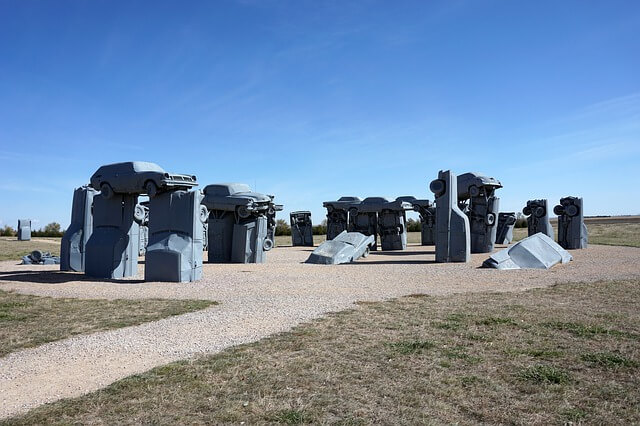
Carhenge is a work of art mimicking Stonehenge in England. It’s located near Alliance, Nebraska. Instead of being built with enormous standing stones like the original Stonehenge, Carhenge was created from 39 vintage American cars, all painted gray. It was built by Jim Reinders in 1987 and in 2006 a visitor center was also built to serve the site.
The Carhenge cars are arranged in a circle, measuring about 96 feet in diameter. Some of them are placed upright and others were welded on top of the supporting cars to form arches. The site has frequently appeared in popular music, commercials, television programs and films and is a famous symbol associated with Nebraska.
Over time, other automobile sculptures were added to the site, which is why it’s now more popularly known as ‘Car Art Reserve’.
State Tree: Cottonwood Tree
Also necklace poplar, the eastern cottonwood tree (Populus deltoids) is a type of cottonwood poplar that’s native to North America and found growing all throughout the central, southwestern and eastern United States. These trees are massive, growing up to 60m tall with a trunk of up to 2.8 meters in diameter, making them one of the largest hardwood trees in North America.
The cottonwood is often used to create objects like furniture (the interior parts) and plywood, since it’s weak, soft and easy to bend. Strongly associated with pioneer Nebraska, the cottonwood shoots were gathered and planted, with many of these trees becoming early landmarks of the state. Today, the cottonwood tree grows throughout the state of Nebraska. In 1972, it was made the official tree of the state.
State Drink: Kool-Aid
Kool-Aid is a famous fruity-flavored drink mix sold in powder form. It was created in 1927 by Edwin Perkins. It’s prepared by mixing with sugar and water, usually by the pitcher, and served chilled or with ice. It’s available in numerous flavors including sugar-free, water and singles flavors as well.
The Kool-Aid logo is the Kool-Aid Man, a character with a large frosty glass pitcher for his body, filled with Kool-Aid. He’s popularly known in printed ads and on TV for bursting through walls while people are making Kool-Aid to say his famous catch phrase: ‘Oh yeah!’.
Now owned by the Kraft Foods Company, Kool-Aid was named the official state drink of Nebraska in 1998.
State Nicknmae: Cornhusker State
Back in 1900, the University of Nebraska sports teams were called the ‘Cornhuskers’ and 45 years later, the state took it as the official nickname to honor its major agricultural industry which was corn. In the past, the task of corn husking (the removal of the husk from corn) was done by hand by the early settlers before husking machinery was invented.
Nebraska prides itself on its corn production which is why the nickname became exceedingly popular and the General Assembly decided to make it the state nickname. Today, Nebraska is considered the ‘breadbasket’ for the United States of American and of many parts of the world.
State River: Platte River
Platte River, designated the state river of Nebraska, is one of the major rivers at about 310 miles long. Over most of its length, the Platte River is a shallow, broad and meandering stream with many islands and a sandy bottom, also known as a ‘braided stream’.
The Platte River serves as an extremely important part of the migration route of continental birds since it provides a habitat for birds, such as whooping cranes and sandhill, who migrate at a certain time of the year. It’s also been of great importance in the past for municipal use and irrigation agricultural purposes. Various cultures of indigenous people lived along the river for many thousands of years before European exploration.
State Bird: Western Meadowlark
The western meadowlark is an icterid bird of medium size, which nests on the ground and is found in open grasslands across central and western North America. Its diet consists mostly of bugs, but it also feeds on berries and seeds. These birds have a black ‘V’ on their breasts, yellow underbelly and white flanks which are also streaked with black. The upper part of their body is mostly brown with black streaks on them. They’re familiar songbirds of the open country across western two thirds of the U.S. in 1929, the General Assembly of Nebraska named the western meadowlark as the official state bird.
State Song: Beautiful Nebraska
Written and composed by Jim Fras and Guy Miller, the popular song ‘Beautiful Nebraska’ became the official song of the state in 1967. According to Jim Fras, the inspiration for the song came to him one day while he was lying down in a farmer’s field south of Lincoln, enjoying the tall grass. He said that it was at that moment he realized how good life could be and he attributed this feeling to the beauty of Nebraska. With the help of his friend Miller, he completed the song which eventually became the regional anthem of his beloved state.
State Poet: John G. Neihardt
John G. Neihardt was an American poet and writer, ethnographer and amateur historian who was born in 1881 at the latter part of the American settlement of the Plains. He gained an interest in the lives of the people who had been a part of the European-American migration and the Indigenous people who were displaced. As a result, he wrote many books in his area of interest.
John published his very first book of poetry back in 1908 and four years later he began to write ‘The Epic Cycle of the West’. These were 5 long poems written in the narrative style which became his chief literary work. It was a unique and substantial contribution to Nebraskan history, leading to his designation as the state’s Poet Laureate in 1921.
Check out our related articles on other popular state symbols:








